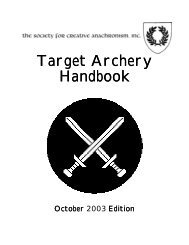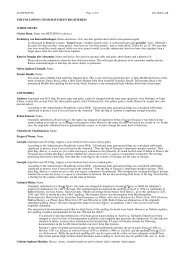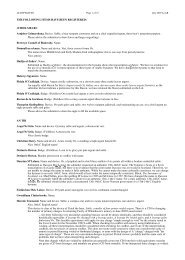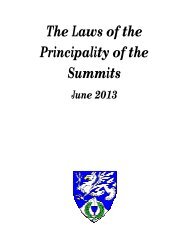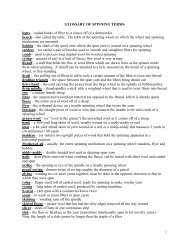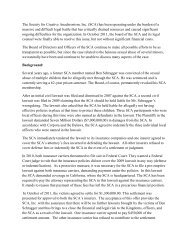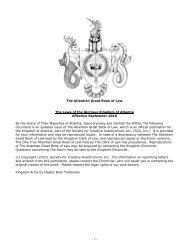The Standards for Evaluation of Names and Armory - SCA Heraldry
The Standards for Evaluation of Names and Armory - SCA Heraldry
The Standards for Evaluation of Names and Armory - SCA Heraldry
Create successful ePaper yourself
Turn your PDF publications into a flip-book with our unique Google optimized e-Paper software.
PN.2. Personal <strong>Names</strong> Style<strong>The</strong> <strong>St<strong>and</strong>ards</strong> <strong>for</strong> <strong>Evaluation</strong> <strong>of</strong> <strong>Names</strong> <strong>and</strong> <strong>Armory</strong>:<strong>The</strong> Rules <strong>for</strong> SubmissionsA. Definitions: A name phrase is a complete given name or byname with associated prepositions, articles <strong>and</strong> thelike. It is defined more thoroughly in PN.1 above, which deals with the construction <strong>of</strong> name phrases. Anaming pool refers to the group <strong>of</strong> name phrases that are in use in a particular time <strong>and</strong> place. <strong>The</strong>se namingpools are organized into regional naming groups, each <strong>of</strong> which includes a group <strong>of</strong> naming pools that aregeographically <strong>and</strong> culturally linked. <strong>The</strong>se regional naming groups are used to determine whether namephrases can be combined in a registerable name. <strong>The</strong> list <strong>of</strong> established regional groups is listed in AppendixC.B. Name Phrase Requirements: A registerable personal name must be made up <strong>of</strong> at least two name phrases: agiven name <strong>and</strong> at least one byname (which may appear to be a second given name). While it is easy todocument individuals who are identified only with a single given name, we do not allow the registration <strong>of</strong>single element personal names. Individuals may use those names, but may not register them.Each name phrase must be grammatically correct <strong>for</strong> its position in a name. In some languages, spellingchanges are used to indicate aspects <strong>of</strong> relationships in bynames. Some languages capitalize some bynames,but consistently use lower case <strong>for</strong> others.For example, because <strong>of</strong> the way Gaelic grammar works, the byname mac Fearchair 'son <strong>of</strong> Fearchar' must bechanged to mhic Fhearchair when it occurs after another byname <strong>of</strong> the <strong>for</strong>m mac X (i.e., when your fatherwas the son <strong>of</strong> Fearchar). So, the son <strong>of</strong> Donnchadh mac Fearchair would be Fionn mac Donnchaidh mhicFhearchair. For example, most Norse descriptive bynames are consistently in lower case. Thus, Halla theskald would be Halla skaldkona, not Halla Skaldkona.C. Name Requirements: A name submission must be consistent with the st<strong>and</strong>ards laid out in this section <strong>for</strong>temporal <strong>and</strong> geographical compatibility. <strong>The</strong> position <strong>of</strong> each name phrase in the overall name must beshown to be appropriate <strong>for</strong> that type <strong>of</strong> name phrase in its language <strong>and</strong> cultural tradition. Some patterns <strong>for</strong>name grammar in important European languages can be found in Appendix A. Any pattern found there doesnot need further documentation; a reference to Appendix A will be sufficient. Other patterns requiredocumentation.For example, there is evidence <strong>for</strong> names in Spanish with two bynames in certain patterns. One pattern is apatronymic byname followed by a placename, as in Ruy Diaz de Bivar. That would justify Juan Perez deMadrid, but would not support the registration <strong>of</strong> Juan de Madrid Perez.In addition, the name as a whole must follow a period pattern <strong>for</strong> personal names. Any name must follow thepattern described in one <strong>of</strong> the two sections below; <strong>for</strong> the purposes <strong>of</strong> this section, name phrases documentedunder the Lingua Anglica allowance in PN.1.B.2.c above are considered equivalent in date <strong>and</strong> language tothe untranslated name element.1. Culturally Uni<strong>for</strong>m <strong>Names</strong>: A culturally uni<strong>for</strong>m name matches a pattern <strong>of</strong> the grammar <strong>of</strong> names <strong>for</strong> asingle time <strong>and</strong> place, such as fourteenth century Engl<strong>and</strong>. This requires that the overall pattern bedocumented to a particular time <strong>and</strong> place, in addition to each name phrase meeting the st<strong>and</strong>ards set out inPN.1 <strong>and</strong> PN.2.B above. This documentation may be a reference to Appendix A.2. Culturally Mixed <strong>Names</strong>: <strong>Names</strong> that mix name phrases from different times <strong>and</strong>/or places are allowed ifthe name meets one <strong>of</strong> the following conditions.a. <strong>The</strong> name mixes name phrases found in a single regional naming group as listed in Appendix C that aredated to within 500 years <strong>of</strong> one another.<strong>St<strong>and</strong>ards</strong> <strong>for</strong> <strong>Evaluation</strong> <strong>of</strong> <strong>Names</strong> <strong>and</strong> <strong>Armory</strong> – April 29, 2012 - Page 12 <strong>of</strong> 73



